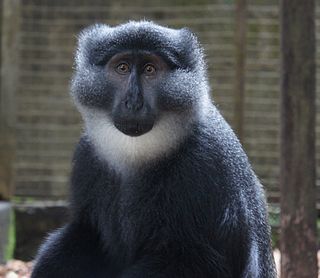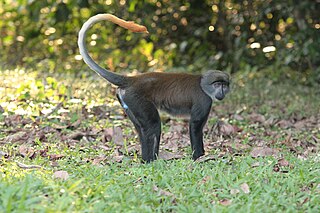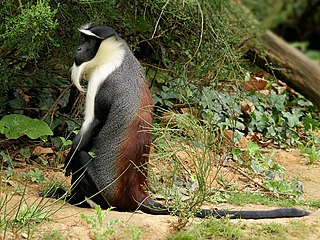
Bushmeat is meat from wildlife species that are hunted for human consumption. Bushmeat represents a primary source of animal protein and a cash-earning commodity for inhabitants of humid tropical forest regions in Africa, Latin America and Asia. Bushmeat is an important food resource in poor, rural communities.

Simian immunodeficiency virus (SIV) is a species of retrovirus that cause persistent infections in at least 45 species of non-human primates. Based on analysis of strains found in four species of monkeys from Bioko Island, which was isolated from the mainland by rising sea levels about 11,000 years ago, it has been concluded that SIV has been present in monkeys and apes for at least 32,000 years, and probably much longer.

The Diana monkey is an Old World monkey found in the high canopy forests in Sierra Leone, Liberia, and western Côte d’Ivoire. Named for its white brow which is said to resemble the bow of the Roman goddess Diana, this black-grey guenon has a white throat, crescent-shaped browband, ruff and beard.

The guenons are Old World monkeys of the genus Cercopithecus. Not all members of this genus have the word "guenon" in their common names; also, because of changes in scientific classification, some monkeys in other genera may have common names that include the word "guenon". Nonetheless, the use of the term guenon for monkeys of this genus is widely accepted.

The Preuss's monkey, also known as Preuss's guenon, is a diurnal primate that lives terrestrially in mountainous forests of eastern Nigeria, western Cameroon and Bioko in Equatorial Guinea. It was formerly classified as a subspecies of the L'Hoest's monkey.

The sun-tailed monkey from Gabon is one of the least studied primates in its habitat. It was discovered as a new species in 1988, and is classified as a guenon, which is a member of the genus Cercopithecus, but was subsequently moved to the genus Allochrocebus. It is closely related to A. preussi and A. Ihoesti, which has been determined by chromosomal analysis. Sun-tailed monkeys prefer shady areas with dense vegetation. However, even after small amounts of logging activity, populations can be unaffected. Much of their diet remains unknown and is still being studied, but they are known to prefer fruit. Their social groups are made up of one male and multiple females. Generally, the sun-tailed monkey is less aggressive towards related individuals, which is noteworthy because it has been found that, in other primate species, aggression rates towards related individuals are generally as high or higher than aggression rates towards non-related individuals. Within their social groups, individual monkeys show preference for their mothers over their fathers, and are overall less aggressive to other monkeys that they are associated with spatially.

Chlorocebus is a genus of medium-sized primates from the family of Old World monkeys. Six species are currently recognized, although some people classify them all as a single species with numerous subspecies. Either way, they make up the entirety of the genus Chlorocebus.

The grivet is an Old World monkey with long white tufts of hair along the sides of its face. Some authorities consider this and all of the members of the genus Chlorocebus to be a single species, Cercopithecus aethiops. As here defined, the grivet is restricted to Ethiopia, Sudan, Djibouti, and Eritrea. In the southern part of its range, it comes into contact with the closely related vervet monkey and Bale Mountains vervet. Hybridization between them is possible, and may present a threat to the vulnerable Bale Mountains vervet. Unlike that species, the grivet is common and rated as least concern by the IUCN.

De Brazza's monkey is an Old World monkey endemic to the riverine and swamp forests of central Africa. The largest species in the guenon family, it is one of the most widespread arboreal African primates. Aside from size, it can be differentiated from other cercopithecus monkeys by its orange diadem and white beard. Due to its cryptic nature, the species is not well documented in all of its habitats but has shown unique traits such as pair-bonding and aggressive behavior towards other guenons.
Simian foamy virus (SFV) is a species of the genus Spumavirus that belongs to the family of Retroviridae. It has been identified in a wide variety of primates, including prosimians, New World and Old World monkeys, as well as apes, and each species has been shown to harbor a unique (species-specific) strain of SFV, including African green monkeys, baboons, macaques, and chimpanzees. As it is related to the more well-known retrovirus human immunodeficiency virus (HIV), its discovery in primates has led to some speculation that HIV may have been spread to the human species in Africa through contact with blood from apes, monkeys, and other primates, most likely through bushmeat-hunting practices.

L'Hoest's monkey, also known as the mountain monkey, is a guenon found in the upper eastern Congo basin. They mostly live in mountainous forest areas in small, female-dominated groups. They have a dark coat and can be distinguished by a characteristic white beard.

Wolf's mona monkey, also called Wolf's guenon, is a colourful Old World monkey in the family Cercopithecidae. It is found in central Africa, primarily between the Democratic Republic of the Congo and Uganda. It lives in primary and secondary lowland rainforest and swamp forest.

The greater spot-nosed monkey or putty-nosed monkey is one of the smallest Old World monkeys. It is a guenon of the C. mitis group, native to West Africa and living to some extent in rain forests, but more often in the transition zone between rain forest and savannah. It is primarily arboreal and often associates with monkeys of other species. Both their common names come from the monkeys' prominent white nose.

The black colobus, or satanic black colobus, is a species of Old World monkey belonging to the genus Colobus. The species is found in a small area of western central Africa. Black colobuses are large, completely covered with black fur, and like all other Colobus monkeys, do not have a thumb. The species has faced large declines in population due to habitat destruction and hunting by humans, and was consequently listed as Vulnerable on the IUCN Red List in 1994.

The red-eared guenon, also called red-eared monkey, or russet-eared guenon is a primate species in the family Cercopithecidae. It is native to subtropical and tropical moist lowland forests in Cameroon, Equatorial Guinea and Nigeria. It is listed as Vulnerable on the IUCN Red List and is threatened by habitat loss, illegal bushmeat hunting and pet trade.

The crested mona monkey, also known as the crowned guenon, crowned monkey, golden-bellied guenon, or golden-bellied monkey,, is a species of African primate in the family Cercopithecidae found in west central Africa.

The Roloway monkey is an endangered species of Old World monkey endemic to tropical West Africa. It was previously considered a subspecies of the Diana monkey. The species is classified as Critically Endangered due to habitat loss and their continued hunting because of the bushmeat trade. The Roloway monkey is mainly an arboreal species, for the most part inhabiting forests in Ghana and some reserves in South-Eastern Côte-D'Ivoire. More specifically, studies have shown that C. roloway is primarily concentrated in the Tanoé forest of the Côte-D'Ivoire because of their heavy threats to extinction and lack of habitat. It is still difficult to gather data on wild subjects, as they have low populations in a vast forest, but they are a unique and vanishing species.

The Niger Delta red colobus is a critically endangered species of colobus monkey endemic to the western part of the Niger Delta. It is threatened by hunting and habitat loss.

The lesula is a species of Old World monkey in the guenon genus Cercopithecus, found in the Lomami Basin of the Congo. Though known to locals, it was unknown to the international scientific community until it was discovered in 2007 and confirmed in a 2012 publication. The lesula is the second new species of African monkey to be discovered since 1984. This monkey is described to have human looking eyes and a blue bottom “And adult males have a huge bare patch of skin in the buttocks, testicles and perianal area,” said John A. Hart, the researcher who described the monkey. “It’s a brilliant blue, really pretty spectacular.”

The red-tailed monkey, also known as the black-cheeked white-nosed monkey, red-tailed guenon, redtail monkey, or Schmidt's guenon, is a species of primate in the family Cercopithecidae.





















